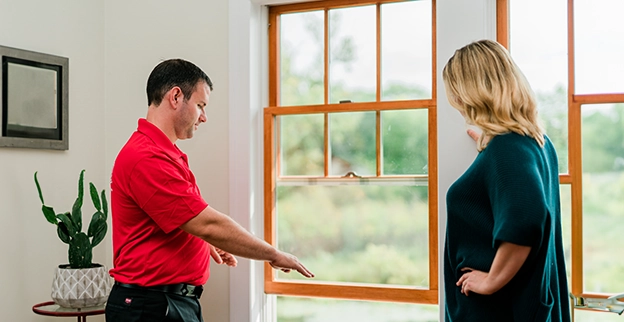You may not know exactly why or when your window started leaking down your wall; all you know is that it's starting to worry you—and it should. If you leave this issue unresolved, not only will it allow moisture into your home to cause property damage, but it can also lessen your home's energy efficiency, leading to higher than necessary energy bills. Moreover, any spaces between your window and the great outdoors mean that pests will find their way inside, making your home theirs too. No matter what type of window you have, it's susceptible to damage.
So, what can you do about it? Call Mr. Handyman for Charlotte window leak repair. A few of the most common problems we can help with include:
Leaks at the top of the window
When you notice a leak coming from the top of your window, it's a sign of improper installation or a missing component. The two main components responsible for sealing windows are:
- Flashing: If the flashing on the outside of your window is damaged or was never applied, you will surely experience a leak. Flashing is the water-repellant adhesive that is applied over your window flanges. As you can imagine, if this crucial element is compromised, water can enter your home.
- House wrap: Like wallpaper but for the exterior of your home, if house wrap is improperly applied, there may not be enough protection to prevent moisture from seeping inside your window. House wrap goes underneath the siding on the outside of your house, and if we suspect that it has been compromised, we'll need to remove the siding to get a good look.
Leaks at the bottom of the window
Windows are designed to allow for water drainage, and water has more than one option to escape. Windows have both a sill pan and drain holes at the bottom, but if either of these features has issues, water could find a way through the window and into your home. The main issue that sill pans face is an improper slope. The pan needs to slope away from the window, and if it isn't, that water will be able to flow in the opposite direction—inside!
As for the drainage holes, sometimes water brings dirt and debris with it—especially if you live near trees. That dirt can clog the drainage holes, leaving the bottom of your window filled with water with nowhere to go but inside.
Addressing these issues means we will either need to clean out the clogged drainage holes or perform a window replacement to create the necessary slope.
Water coming in from around the window
Most times, if water is coming in anywhere around your entire window, it's because the caulk or sealant has lost its grip or is damaged and peeling. Even a small crack in the sealant can let the water come inside your home, but thankfully, this particular problem is easy to resolve. All we'll need to do is remove the old caulking or sealant and apply a new coat.
Leaks in between the window panes
If your windows are old, there's a good chance they are leaking because the glass seal has worn away. In double-pane windows, gas is trapped between the panes for insulation. If the glass seal is gone, then the gas will escape, and water can be let inside. You may not experience a leak inside your home, but you don't want water trapped inside your windows either, as it can eventually create perfect mold conditions. A compromised glass seal can also lower your home's energy efficiency and increase the price you pay for utilities.





